| TYPES OF PRINTER INK |
 |
| In the world of fine art reproduction and commercial printing, there are many considerations to be made prior to the actual printing process. In addition to paper and canvas selections, printer formats and qualities, and choices of display, the customer must determine what type of ink is best suited to the future use of his or her print.
Scan the table below to see a simplified breakdown of the different types of printer inks available on the market today, and then read on for more information on each type.
|
SUMMARY
| INK TYPE |
MANUFACTURE |
USES |
| AQUEOUS |
Water-based ink mixed with a colored powder (pigment) or a dye. |
Canvas and paper fine art prints, indoor use |
| SOLVENT |
A solvent (volatile organic compound) mixed with colored powder (pigment). |
Plastic prints for outdoor signage and displays |
| ECO-SOLVENT |
A mild solvent mixed with colored powder (pigment); can be used in enclosed spaces. |
Plastic prints for outdoor signage and displays |
| INDIGO |
A very fine-particle pigment is mixed in the printer with an oil carrier. |
Digital photobooks, canvas prints, plastics |
| LATEX |
Water-based ink mixed with a latex polymer dye. |
Large format, industrial, outdoor displays |
| TONER |
An alternative to ink used in laser printers; remains in a powdered form until fused to the paper. |
Everyday printing needs, documents, posters |
| UV CURABLE |
Usually pigment ink, cured (dried) by UV light before exiting the printer |
Generally industrial, large format production |
| DYE SUB |
Aqueous or solvent dye sublimation ink |
Dye sublimation & Diffusion |
|
| AQUEOUS INKS |
 |
|
Aqueous inks are those that use water as a carrier for the colored substance, which can be either dye or pigment.
Dye-based aqueous inks stain the page when applied, and dry on the paper or canvas as the water evaportates. Very tiny dots of color can be created with dye-based inks, resulting in a high quality, smooth print. They also produce very bright colors. However, dye-based inks will spread and stain again if water is reapplied - they are not waterproof and any moisture can damage the print. Additionally, the colors will fade over time due from the UV rays in sun- and natural light.
Pigment-based aqueous inks combine a powdered substance similar to chalk dust with the water carrier. Since the pigment sits on top of the paper instead of staining it, pigment inks scatter light and result in a slightly more muted colors than dye-based inks. However, the dot size is only minimally larger than dye inks, and the final product will be waterproof. Pigment inks are also stable in (resistant to) UV light.
Any substrate - fine art or photographic paper, canvas - must be treated with an ink receptive coating prior to being printed with aqueous ink.
|
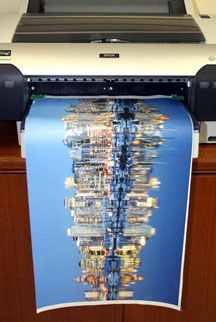
|
| SOLVENT INKS |
 |
|
Solvent inks are pigment-based like aqueous inks, but the difference lies in their carrier. Instead of water, solvent inks use volatile organic compounds - known as solvents. These inks are less expensive, and can be used on uncoated substrates such as vinyl, for printing adhesive decals, billboards, and banners used in outdoor displays. In fact, solvent inks work much better on plastic than paper or canvas. This is because non-polar inks (like solvents) adhere better to non-polar surfaces (like plastic).
Though the printed color is not as strong as aqueous inks, solvent-based inks are generally safe from water and UV light. The hardy weather-resistant print that results makes them the ideal ink for large, outdoor presentations. Negatives of this type of ink are: the ventilation needed during printing and drying due to the dangerous fumes of the solvent, and their inflexibility when it comes to different substrates.
|
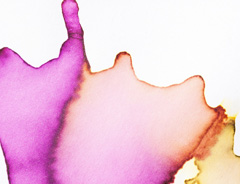
|
| ECO-SOLVENT INKS |
 |
|
Because of the dangers inherent in printing with solvent inks, in recent years "eco-solvent inks", also called mild solvent inks, have been developed. This new type of ink allows for printing in enclosed spaces without the risk of the print technician inhaling dangerous fumes. Though the original eco inks were not of comparable quality, today the color and durability of these safer inks is much improved, and the price is steadily decreasing.
|

|
| INDIGO INKS |
 |
|
A type of ink recently designed by Hewlett-Packard, Indigo ink is composed of charged pigment in a carrier liquid. Though the ink is dispersed in the same way as in other inkjet printers, indigo ink has extremely fine particles, allowing the printer to produce images at 2400 DPI (dots per inch).
The ink is installed in the printer as a paste. Once it is in place, it is diluted with a combination of oil and color particles before being applied to the paper. Currently, indigo ink is widely used by photobook printers, and has been ascribed a lifespan of more than 50 years in indirect light before any noticeable fading occurs, and up to 200 years in a dark area (photo albums).
Indigo ink has been shown to work well in printing on a wide variety of paper types, as well as canvas and plastics.
|
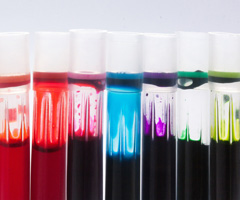
|
| LATEX INKS |
 |
|
Currently available from few suppliers, latex inks are some of the newest on the market, and is being presented primarily as an alternative to solvent inks. Some reports suggest latex ink offers improved print quality on vinyl, as well as most other substrates with which solvent inks have difficulty. A water carrier is mixed with a polymer dye, which is then applied to the substrate using heat. Unlike traditional solvent inks, latex inks are odorless, which eliminates ventilation issues.
Manufacturers have stated latex inks will retain their appearance outdoors for three years without requiring lamination. The print is also dry immediately upon extraction from the printer, removing the additional time required for other inks, referred to as an "outgassing" period.
|
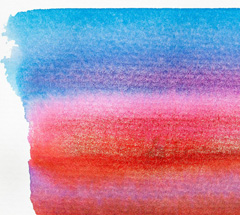
|
| TONER INKS |
 |
|
Toner is technically an alternative to ink, and is commonly used in laser printers. It consists of carbon powder, iron oxide and a polymer, and is inserted into the printer within in a cartridge, in its powdered form. When the powder meets the heat of the fuser within the printer, it is affixed (fused) to the paper.
Depending on the printer and the qualities desired, different polymers used in the toner can produce various results. The size of the powder granules and the heat at which they will melt or fuse to the paper can be affected by the type of polymer. Today, quality controls ensure that the granules are very small, which allows laser printers to print at 600 DPI (dots per inch).
|
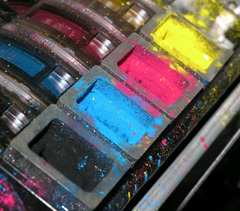
|
| UV CURABLE INKS |
 |
|
UV-curable inks must go through a curing process once printed, by exposure to a strong UV light source. Once the ink has been cured, the print is completely dry. This is one positive of this type of ink, along with its versatility - many uncoated substrates can be printed with UV curable ink, which also results in very bright, bold colors.
However, these inks are quite expensive, requiring not only the purchase of the ink itself, but also a printer with a built-in curing function. This type of ink is also rather heavy, which creates a raised surface on the substrate and may also result in cracking on flexible materials (though advances in this area are being made).
UV curable inks are often used on hard substrates such as wood, plastic or metal. This is done using a flatbed printer, which does not require the substrate to be rolled prior to printing, but rather prints directly onto the flat surface.
Though both dye- and pigment-based versions exist, pigment is the most common choice due to its long lasting color and durability.
|

|
| DYE SUBLIMATION INKS |
 |
|
The dye sublimation inks are a pigment suspended in a liquid solvent, like water. The images are initially printed on coated heat-resistant transfer paper as a reverse image of the final design, which is then transferred onto polyester fabric or many other surfaces like Aluminum panels in a heat press operating at a temperature around 180 to 210 C (375 F).
|
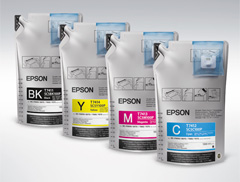
Epson UltraChrome DS INKS
|
| As this article shows, there is a wide variety of ink types available, and more are being developed each year. Though research is required to determine the best ink for each individual printing requirement, you can rest assured that the perfect printer for your needs is out there. When you are searching for a commercial printer, be sure to enquire as to what type of ink they use and whether it is suited to your project.
KeenART Media is the ideal company to provide your fine art reproductions and long-lasting, archival quality indoor prints. Whether you want a family photo immortalized as a canvas print or copies of your paintings produced for sale, KeenART guarantees a superior finished product. If you have any questions about our services, do not hesitate to contact us.
|
|

|



|
USA Giclee On Canvas, Fine Art Printing - Art Scanning & Reproductions - Handmade Oil Paintings - Custom Wood Panels, Metal Picture Framing - Block/Plaque Mountings, Large Format Dry Mounting & Lamination - Art Supplies: Stretcher Bars, Cradled Wood Panels and Artist Canvas - Collages On Canvas - Plexi/Acrylic Face Mounts - Block Acrylics, Fabric Printing, Dye Sublimation - Cityscape Skyline Prints, Resin, Photo Gifts and more...
|
|
© 2002-2025 - KeenART Media Ltd.
|
|
| |
|
